At thirteen years old, Gushi Khan exhibited bravery and battle skills. He led his troops to defeat a force of 10,000 (some claim 40,000) soldiers from the “Mgo Gkar” ethnic group, who followed Islam.
In 1606, his mother Ahaiha Tun passed away. Using his family’s wealth, he generously distributed alms and performed rituals to aid his mother’s soul, which earned him the support and loyalty of his people. That same year, conflict arose between the Qalqa Mongols and the Oirat Tribe, and Gushi Khan skillfully mediated between the factions.
Consequently, Jamyang Gyatso, representing the Gelug sect (Yellow Sect) of Tibetan Buddhism and the leader of the Khalkha Tribe, bestowed upon him the title of “Great Guru.” With this new title, Gushi Khan changed his name accordingly and dedicated himself to the Yellow Sect, even funding the translation of numerous Buddhist scriptures.
In 1630, Gushi Khan dispatched envoys to establish contact with local authorities in Ufa, Russia. In the seventh year, he clashed with Russia, and in the eighth year, he journeyed through Qinghai alongside the leader of the Dzungar Tribe, Batu Erhentaiji. During the ninth year, he reached Lhasa and received the title of “Tenzin Choegyal” (Venerable Protectorate) from the 5th Dalai Lama and the 4th Panchen Lama. In the autumn of the ninth year, supported by the Khoshut Tribe, Gushi Khan led his troops southward into Qinghai, intending to eventually occupy the Tibetan region.
Gushi Khan defeated and took control of Qinghai after killing Qutu Khan and his 40,000 followers. Later, he conquered the Kham region and Tibet, gaining political power and promoting the Yellow Sect. To establish friendly relations, he sent envoys to Tibet. The envoys received a warm welcome in Tibet. Gushi Khan esteemed the 4th Panchen Lama as his master. He played a major role in strengthening the relationship between Tibet and the Mongols.
Biography of Gushi Khan
Gushi Khan, a prominent Oirat Mongol leader, emerged during the late Ming and early Qing Dynasties. He used force to stabilize the chaotic Qinghai-Tibet Plateau and allied with the Geluk Sect. His actions played a significant role in unifying the diverse ethnic groups and furthering their development. Originally named Tulu Hubai, Gushi Khan was recognized for his intelligence and cleverness.
In 1606, a war broke out between Oirat Mongolia and Khalkha Mongolia on the Mongolian Plateau. Gushi Khan bravely stepped forward and successfully ended the war. His prestige and intelligence earned him the respect of all parties involved in the mediation. In 1618, the Shingshakpa family established the Desi Tsangpa regime in opposition to the Gelug Sect. Gushi Khan came to the rescue and became a guardian of the Yellow Sect. He strategically disguised himself as a pilgrim to gather information and persuaded Arslan to change his attitude towards the Yellow Sect. Gushi Khan then led an army to eliminate Quetu Khan and Beri Chieftain.
In 1642, he marched into Tibet and ended the rule of Tsangba Khan. Gushi Khan became the ruler of the entire Qinghai-Tibet Plateau and established a local government in Tibet. He consolidated his power through military command, legal reforms, and administrative institutions. Gushi Khan’s efforts led to the confirmation of the Dalai Lama’s religious leadership status. Gu Shihan died in 1656, leaving behind a legacy of heroism, unification of the Qinghai-Tibet Plateau, and contribution to the consolidation and development of a unified multi-ethnic Tibet.















